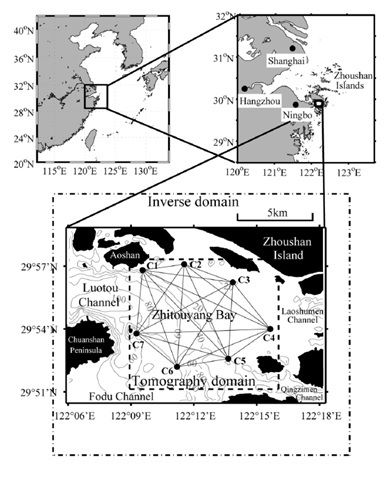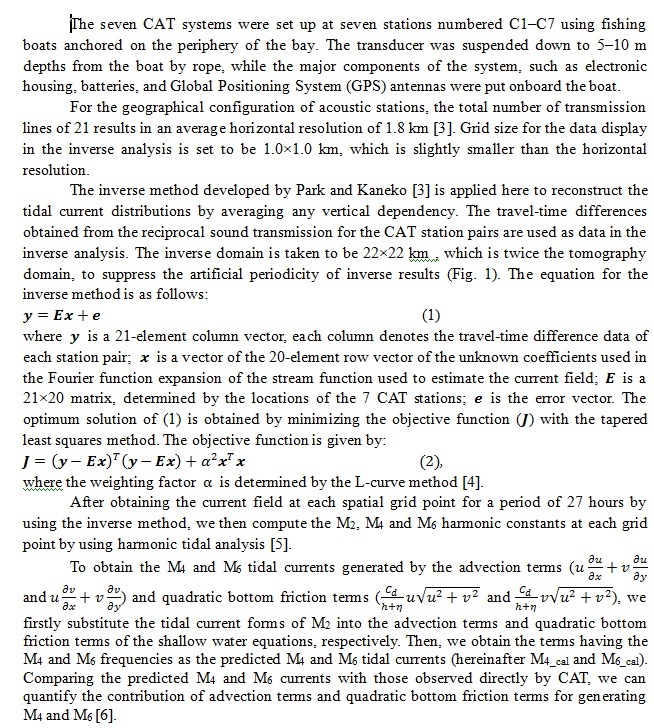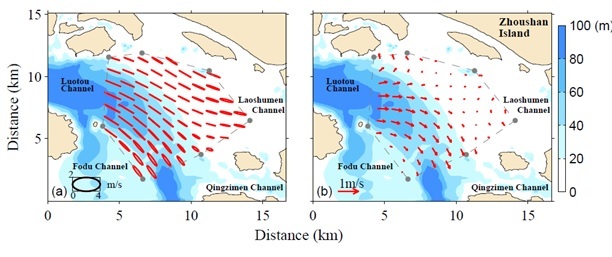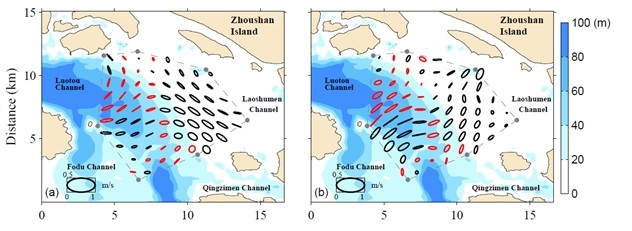BISAC NAT010000 Ecology
BISAC NAT045050 Ecosystems & Habitats / Coastal Regions & Shorelines
BISAC NAT025000 Ecosystems & Habitats / Oceans & Seas
BISAC NAT045030 Ecosystems & Habitats / Polar Regions
BISAC SCI081000 Earth Sciences / Hydrology
BISAC SCI092000 Global Warming & Climate Change
BISAC SCI020000 Life Sciences / Ecology
BISAC SCI039000 Life Sciences / Marine Biology
BISAC SOC053000 Regional Studies
BISAC TEC060000 Marine & Naval
A coastal acoustic tomography (CAT) experiment for mapping the tidal currents in the Zhitouyang Bay was successfully carried out with seven acoustic stations during July 12 to 13, 2009. The horizontal distributions of tidal current in the tomography domain are calculated by the inverse analysis in which the travel time differences for sound traveling reciprocally are used as data. Spatial mean amplitude ratios M2 : M4 : M6 are 1.00 : 0.15 : 0.11. The shallow-water equations are used to analyze the generation mechanisms of M4 and M6. In the deep area, velocity amplitudes of M4 measured by CAT agree well with those of M4 predicted by the advection terms in the shallow water equations, indicating that M4 in the deep area where water depths are larger than 60 m is predominantly generated by the advection terms. M6 measured by CAT and M6 predicted by the nonlinear quadratic bottom friction terms agree well in the area where water depths are less than 20 m, indicating that friction mechanisms are predominant for generating M6 in the shallow area. Dynamic analysis of the residual currents using the tidally averaged momentum equation shows that spatial mean values of the horizontal pressure gradient due to residual sea level and of the advection of residual currents together contribute about 75% of the spatial mean values of the advection by the tidal currents, indicating that residual currents in this bay are induced mainly by the nonlinear effects of tidal currents.
tidal current structures, residual currents, M4 and M6 generation mechanisms, coastal acoustic tomography
I. INTRODUCTION
The continuous monitoring of tidal currents in bays, inland seas, and straits over a large area is difficult, especially in the coastal seas of China, where fishing and shipping pressures are high. Furthermore, in order to examine generation mechanisms of the nonlinear tidal currents, the 2-dimensional continuous current field also should be mapped accurately to allow calculation of the advection terms.
To obtain observations of rapidly varying tidal current structures, bottom-mounted or subsurface moored current meter arrays are needed as conventional tools. However, heavy shipping traffic and fishery activities make it difficult to deploy such mooring arrays in almost all coastal regions in China, even if the antitrawl bottom-mounted acoustic Doppler current profiler (ADCP) systems are applicable. Coastal Acoustic Tomography (CAT) can achieve this easily by deploying only a few instruments on the periphery of the observation region [1]-[2].
II. SITE AND METHOD
An experiment with seven CAT systems was performed on July 12–13, 2009, in a neap tidal period at Zhitouyang Bay (hereinafter ZTYB) near Zhoushan Island around the mouth of Hangzhou Bay, China (Fig. 1).

Fig. 1 Location maps of the experimental site. The positions of the CAT stations (C1–C7) are shown with solid circles. The thick solid lines connecting the CAT stations indicate the sound transmission lines. The interval of bathymetric contours is 20 m.

III. RESULTS AND DISCUSSION
A. Horizontal distribution of tidal current
The inversion results provide synoptic snapshots of horizontal tidal current distributions at hourly intervals. The hourly mean tidal current structures from 18:00:00 July 12, 2009 to 17:00:00 July 13, 2009, are shown in Fig. 2. The strong eastward tidal current, with a maximum current of 2.05 m/s, entered the tomography site from the Luotou channel at the western part of the bay and separated into two branches flowing into the Laoshumen channel and the Qingzimen and Fodu channels during the ebb tide (Fig. 2a–2c). During the flood tide, the strong westward tidal current, with a maximum current of 1.03 m/s, merged with the currents from the Laoshumen, Qingzimen, and Fodu channels and went back to the Luotou channel during the flood tide (Fig. 2f–2h). This tidal current variation was repeated at the half-day cycle.
.jpg)
B. Harmonic analysis of tidal currents
The harmonic analysis showed that the M2 tide was the predominant tidal constituent. The semimajor axes of the tidal ellipse were directed to the east–west at the western half of the site and were separated into two directions at the eastern half (Fig. 3a). The mean semimajor and semiminor axes of the tidal ellipses were 1.00 and 0.07 m/s, respectively. The vector plot of the residual current is shown in Fig. 3b. The residual current was strong near the Luotou channel and became weak in the eastern part of the bay. The residual current flowed out as the eastward current from the Luotou channel and then turned southward along the 40-m bathymetric contour in the middle of the site.

Fig. 3 The distribution of (a) M2 tidal current ellipses, and (b) residual currents in Zhitouyang Bay. The gray solid circles are the positions of the CAT stations (C1-C7). The area enclosed by the dashed lines indicates the CAT observational region.
The spatially-averaged amplitude ratios M2 : M4 : M6 are 1.00 : 0.15 : 0.11. The relatively large M4 and M6 overtides were observed in ZTYB. Then, we will discuss the generation mechanisms of M4 and M6 by using the ZTYB CAT data.
The horizontal distribution of the M4 tidal ellipses measured by CAT and those of M4_cal are shown in Fig. 4. The M4 currents (Fig. 4a) are relatively large near the Luotou and Qinzimen channels with a maximum value 0.27 m s-1, corresponding well to the distribution of the M2 tidal current (Fig.3a). The area averaged semimajor and semiminor axis lengths of the M4 tidal ellipses are 0.15 and 0.04 m/s, respectively (Table 1). The spatial mean ellipticity of the M4 tide is 0.27, which is larger than that of M2 (0.07). The M4_cal currents (Fig. 4b) are also relatively large near the Luotou and Qinzimen channels with a maximum value 0.32 m/s near Luotou channel. The M4_cal ellipses have the same area averaged semimajor and semiminor axis lengths as the observed M4 values (Table 1).
The M4 semimajor axis direction is mainly northeast-southwest in the west part of the observation region, and becomes northwest-southeast in the east part (Fig. 4a). The M4_cal semimajor axis direction is mainly northeast-southwest in the west part of the region, and becomes north-south in the east part (Fig. 4b).
We compare the velocity amplitudes of M4 and M4_cal to confirm the contribution of advection terms in generating the M4 tide in different areas of the observational region. We consider the M4_and M4_cal ellipses to be similar at those points (red ellipses in Fig. 4) for which the differences of both velocity amplitude and phase between M4_and M4_cal are less than one STD of the differences between the M4_and M4_cal values, i.e., 0.07m s-1 and 110º, respectively. We find that the tidal current ellipses are most similar in the deep area where water depths are larger than 60 m. The distribution of M2 ellipses (Fig.3a) shows that relatively large M2 currents appear in the deep area, which means the values of the advection terms are also larger in the deep area. Thus the advection terms make a primary contribution to M4 generation in the deep area. Moreover the tidal current ellipses (black ellipses in Fig. 4) are not generally similar in shallow waters, that is to say the M4 tidal currents in the shallow area are not mainly caused by the advection terms. There are other key factors for generating M4 in the shallow area, such as the continuity terms or the friction mechanism [7].

Fig. 4 Tidal current ellipses of (a) M4, and (b) M4_cal. Red lines indicate similar ellipses for M4 and M4_cal. The area enclosed by the dashed lines indicates the CAT observational region.
The horizontal distribution of the M6 tidal ellipses measured by CAT and those of M6_cal are shown in Fig. 5. The maximum value of the M6 semimajor axes is 0.20 m/s, appearing near Luotou channel. The spatial mean semimajor and semiminor axis lengths of the M6 current ellipses are 0.11 and 0.03 m/s (Table 1). The M6 ellipticity is relatively small in the north part of the observational region, and becomes larger near Fodu channel. The spatial mean value of ellipticity is 0.27. The M6_cal currents (Fig. 5b) are relatively larger near Luotou channel with a maximum value 0.10 m/s. The spatial mean semimajor and semiminor axis lengths of the M6_cal tidal current ellipses are 0.07 and 0.01 m s-1, respectively (Table 1). The spatial mean ellipticity of the M6_cal tide is 0.09.
The orientations of the M6 and M6_cal tidal current ellipses correspond well throughout the observational region: both are mainly directed east-west in the north part of the observational region, and turn north-south along the 40 m bathymetric contour.
We further show the relationship of M6_and M6_cal velocity amplitudes to confirm the contribution of the quadratic bottom friction terms to the generation of M6 in different areas of the observational region. We consider the M6 and M6_cal ellipses to be similar at those points (red ellipses in Fig. 5) for which the difference of velocity amplitude between M6_and M6_cal is less than the STD of the differences between the M6_and M6_cal values (i.e., 0.05m s-1). Where the tidal current ellipses are similar (red ellipses in Fig. 5) this similarity indicates M6 mainly generated by the quadratic bottom friction terms; this occurs principally in the east part of the observational region where water depth is less than 20 m. These results indicate that the quadratic bottom friction terms play a primary role for generating M6 in shallow waters, while M6 in the deep area is also affected by such factors such as the other nonlinear terms in the momentum equations [8].
)).jpg)
Fig. 5 Tidal current ellipses of (a) M6, and (b) M6_cal. Red lines indicate similar ellipses for M6 and M6_cal. The area enclosed by the dashed lines indicates the CAT observational region.
Table 1. Spatial mean parameters of tidal current ellipses of M4, M4_cal, M6, M6_cal and their STDs
|
|
M4 |
M4_cal |
M6 |
M6_cal |
|
Semimajor axis length±STDs (m/s) |
0.15±0.05 |
0.15±0.07 |
0.11±0.04 |
0.07±0.02 |
|
Semiminor axis length±STDs (m/s) |
0.04±0.03 |
0.04±0.03 |
0.03±0.02 |
0.01±0.00 |
C. Dynamic mechanisms of residual currents
.jpg) .
.
.jpg)
Table 2. Maximum and average values (in units of 10-6 m/s2) of dynamic terms in the tidally averaged momentum equation, and percentages of each term relative to the forcing term.
|
|
|
|
|
|
|
|
|
Maximum value |
336 |
176 |
0.08 |
75 |
48.7 |
11.0 |
|
Percentage,% |
100 |
52.4 |
0.02 |
22.3 |
14.5 |
3.3 |
|
Average value |
125 |
47.4 |
0.5 |
8.1 |
18.3 |
5.2 |
|
Percentage,% |
100 |
37.9 |
0.4 |
6.5 |
14.6 |
4.2 |
IV. Summary
In this study, we use CAT data to reconstruct the horizontal distributions of tidal currents and residual currents in ZTYB. Furthermore, we also demonstrate that the overtides M4 and M6 are mainly generated by the nonlinear advection and quadratic bottom friction terms of M2, respectively. All these results indicate that the M4 and M6 tidal currents directly measured by the CAT are credible. To the best of our knowledge, this study is the first nonlinear tidal current measurement by CAT.
We also analyze the main dynamic processes responsible for the residual currents by using the averaged horizontal momentum equation. The predominant terms in balancing the momentum equation of the residual currents are advection of the tidal currents, horizontal pressure gradient, and advection of the residual currents, while the bottom friction and Coriolis force terms contribute less.
The results show the advantages of the CAT system for accurately mapping horizontal variations of tidal currents and residual currents. Our study suggests that CAT measurements have advantages for current monitoring over a large area and understanding dynamic mechanisms in coastal regions.
V. ACKNOWLEDGEMENT
This study is supported by the National Natural Science Foundation of China (41276095, 41476020, 41576001, 41321004 and 41576031); the Scientific Research Fund of SIO under grant JT1402; the projects of the State Key Laboratory of Satellite Ocean Environment Dynamics, SIO (SOEDZZ1501); the National Programme on Global Change and Air-Sea Interaction (GASI-IPOVAI-01-02).
1. H. Yamaoka, A. Kaneko, J.-H. Park, H. Zheng, N. Gohda, T. Takano, et al., “Coastal acoustic tomography system and its field application,” IEEE Journal of Oceanic Engineering, 27(2), pp. 283-295, 2002.
2. X.-H. Zhu, A. Kaneko, Q. Wu, C. Zhang, N. Taniguchi, and N. Gohda,. “Mapping tidal current structures in Zhitouyang Bay, China, using coastal acoustic tomography,” IEEE Journal of Oceanic Engineering, 38(2), pp. 285-296, 2013.
3. J.-H. Park, and A. Kaneko, “Computer simulation of the coastal acoustic tomography by a two-dimensional vortex model,” Journal of Oceanography, 57, pp. 593-602, 2001.
4. P. C. Hansen, and D. P. O’Leary, “The use of the L-cure in the regularization of discrete ill-posed problems,” SIAM J. Sci. Comput., 14(6), pp. 1487-1503, 1993.
5. R. Pawlowicz, B. Beardsley, and S. Lentz, “Classical tidal harmonic analysis including error estimates in MATLAB using T_TIDE,” Computers and Geosciences, 28, pp. 929-937, 2002.
6. X.-H. Zhu, Z.-N. Zhu, and X. Guo, “Coastal tomographic mapping of nonlinear tidal currents and residual currents,” Continental Shelf Research, under review.
7. B. B. Parker, “The relative importance of the various nonlinear mechanisms in a wide range of tidal interactions (review),” In Tidal Hydrodynamics, Parker, B. B (Ed.), Wiley New York, USA, pp. 237-268, 1991.
8. J. Sheng, and L.Wang, “Numerical study of tidal circulation and nonlinear dynamics in Lunenburg Bay, Nova Scotia,” Journal of Geophysical Research, 109, C10018, doihttps://doi.org/10.1029/2004JC002404, 2004.
9. X.-H. Zhu, Z.-N. Zhu, X. Guo, Y.-L. Ma, X. Fan, M. Dong, and C. Zhang, “Measurement of tidal and residual currents and volume transport through the Qiongzhou Strait using coastal acoustic tomography,” Continental Shelf Research, 108, 65-75, 2015.
10. M. Cáceres, A. Valle-Levinson, and L. Atkinson, “Observations of cross-channel structure of flow in an energetic tidal channel,” Journal of Geophysical Research, 108 (C4), 3114, doihttps://doi.org/10.1029/2001JC000968, 2003.







